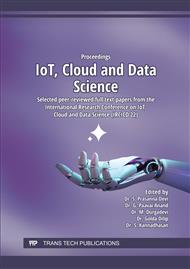[1]
W. Liu, G. Wu, F. Ren, and X. Kang, DFF-ResNet: An insect pest recognition model based on residual networks,, in Big Data Mining and Analytics, vol. 3, no. 4, pp.300-310, Dec. 2020,.
DOI: 10.26599/bdma.2020.9020021
Google Scholar
[2]
M. Das and A. Bais, DeepVeg: Deep Learning Model for Segmentation of Weed, Canola, and Canola Flea Beetle Damage,, in IEEE Access, vol. 9, pp.119367-119380, 2021,.
DOI: 10.1109/access.2021.3108003
Google Scholar
[3]
L. Li, S. Zhang and B. Wang, Plant Disease Detection and Classification by Deep Learning—A Review,, in IEEE Access, vol. 9, pp.56683-56698, 2021,.
DOI: 10.1109/access.2021.3069646
Google Scholar
[4]
Y. -S. Chen, C. -S. Hsu and C. -L. Lo, An Entire-and-Partial Feature Transfer Learning Approach for Detecting the Frequency of Pest Occurrence,, in IEEE Access, vol. 8, pp.92490-92502, 2020,.
DOI: 10.1109/access.2020.2992520
Google Scholar
[5]
E. C. Tetila, B. Brandoli Machado, G. V. Menezes, N. A. de Souza Belete, G. Astolfi and H. Pistori, A Deep-Learning Approach for Automatic Counting of Soybean Insect Pests,, in IEEE Geoscience and Remote Sensing Letters, vol. 17, no. 10, pp.1837-1841, Oct. 2020,.
DOI: 10.1109/lgrs.2019.2954735
Google Scholar
[6]
Q. Dai, X. Cheng, Y. Qiao and Y. Zhang, Agricultural Pest Super-Resolution and Identification With Attention Enhanced Residual and Dense Fusion Generative and Adversarial Network,, in IEEE Access, vol. 8, pp.81943-81959, 2020,.
DOI: 10.1109/access.2020.2991552
Google Scholar
[7]
L. Liu et al., PestNet: An End-to-End Deep Learning Approach for Large-Scale Multi-Class Pest Detection and Classification,, in IEEE Access, vol. 7, pp.45301-45312, 2019,.
DOI: 10.1109/access.2019.2909522
Google Scholar
[8]
H. Pan, Z. Pang, Y. Wang, Y. Wang and L. Chen, A New Image Recognition and Classification Method Combining Transfer Learning Algorithm and MobileNet Model for Welding Defects,, in IEEE Access, vol. 8, pp.119951-119960, 2020,.
DOI: 10.1109/access.2020.3005450
Google Scholar
[9]
F. Ren, W. Liu and G. Wu, Feature Reuse Residual Networks for Insect Pest Recognition,, in IEEE Access, vol. 7, pp.122758-122768, 2019,.
DOI: 10.1109/access.2019.2938194
Google Scholar
[10]
K. Kadam, S. Ahirrao, K. Kotecha and S. Sahu, Detection and Localization of Multiple Image Splicing Using MobileNet V1,, in IEEE Access, vol. 9, pp.162499-162519, 2021,.
DOI: 10.1109/access.2021.3130342
Google Scholar


